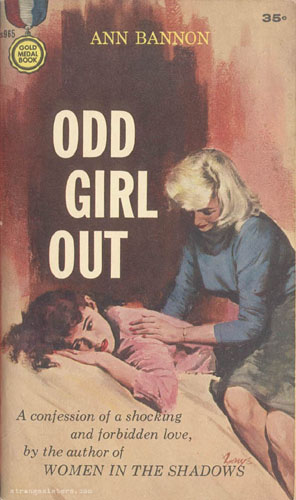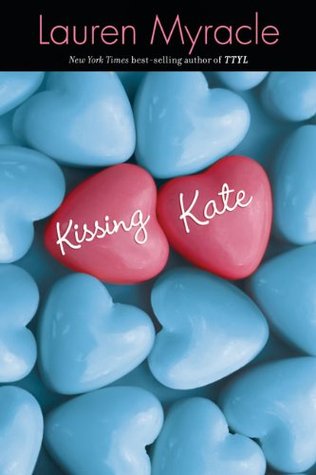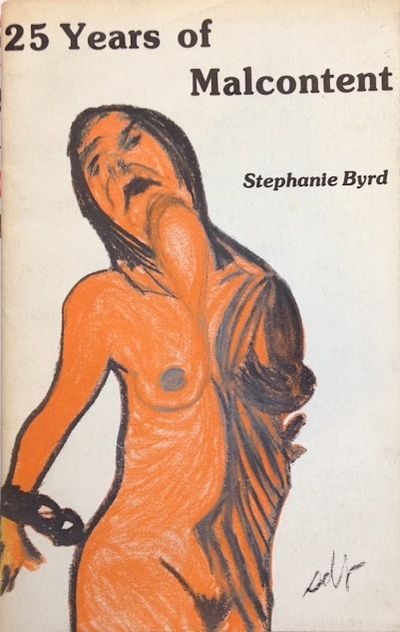
Ann Bannon’s pulp novel Odd Girl Out (the first of the famous Beebo Brinker series) is the first, and so far only, 1950s lesbian pulp novel I’ve read. I knew vaguely going into this that things didn’t usually work out so well for the lesbians in these books—publishers usually insisted on a distinct lack of happy endings, you know, in case someone thought they might be advancing a homosexual agenda! But I was trying to reserve my judgement until I’d actually read one of these pulp novels, and I naively got about a third of the way through Odd Girl Out thinking, wow, this love story is actually quite adorable and Bannon’s observations on the social conventions of 50s college life are actually quite fascinating. Of course, Bannon had to go and ruin it by making one of the girls eventually fall for the so-called superior charms of a man; but, I’d like to see if I can tease out something a bit more positive that I can take from this novel. Here goes!
Essentially, Odd Girl Out is the story of Laura, a sheltered young woman who has just started college; she’s intrigued by and then falls for her roommate, the tomboyish, confident older student Beth. The erotic tension in the early stages of Laura and Beth’s relationship is quite well done; I vividly remember the scene where they go to the movies together and shyly begin to hold hands. So cute! Bannon really nailed the excitement/terror of delirious young love that produces that ‘I think I might be sick but I’m really happy anyway’ feeling. In a way, the fact that Beth and Laura’s relationship is initially so sweet makes Beth moving onto Charlie—aptly described by Mfred in her review as “an odd combination of tender and caveman, having his way in the name of Good & Manly Decision-making whenever the plot requires it”—all the more brutal, but I’m willing to give Bannon some credit here. She does a great job showing us why Beth is so attractive, and I was actually surprised that it was her who ended up dating a man, and not Laura, because Beth is definitely more masculine; I’m guessing that allowing the more feminine Laura to embrace her queerness—as much as that’s possible in 1957—would have been revolutionary and unexpected for the time. You end up cheering her on at the end. I wanted to tell Laura as she head off to Greenwich Village by herself after being ditched by Beth at the last minute: “Don’t you worry about that traitor Beth, you’re going to find lots of cute dykes in NYC!”
The subplot involves Beth’s friend Emmy, who is kicked out of college for (gasp!) wearing a sexy costume that ‘accidentally’ reveals a bit too much at a party and then having pre-marital sex with her boyfriend whom the college forbad her from seeing. This story is actually quite illuminating. Can you believe that post-secondary institutions really had that kind of ridiculous control over female students? After Emmy is forced to leave school, her boyfriend Bud promises to marry her, but Bannon leaves a distinct amount of doubt as to whether Bud is really going to do anything of the sort. She makes it clear that Bud is privileged, able to continue school and to pursue his career as a musician while Emmy is sent home and punished. Emmy is caught in a double bind: she’s booted out of school for her relationship with a man, but then her only hope for redemption is marriage. So, Bannon is actually pointing out the flaws of heterosexual patriarchy, the very thing that Beth so happily accepts at the end of the novel. There aren’t any explicit links drawn between Beth and Emmy’s situations, and likely Bannon intended Charlie to epitomize ‘one of those few good men left in the world,’ but I couldn’t help but wonder whether Bannon wasn’t really slyly critiquing the ways that patriarchal societies, on the one hand, teach women to depend only on men and to use their sexuality to secure one, and, on the other, punish women for their so-called weakness and call them sluts for expressing their sexualities. In the end, the lesbian Laura is the only female character free of these restraints. Now that is something I—and I think other modern readers—can appreciate, despite this novel’s dated flaws.




mfred3 says
This is a great review! It really did seem like Laura had the happiest ending of all the characters. I think she shows up again in the Beebo books by Bannon, but I haven’t had a chance to read them.
caseythecanadianlesbrarian says
Thanks! I thought your description of Charlie was spot-on. I think I’ll give the other books a try too, especially if you get to find out what happens to Laura, and now that I am more prepared about what to expect!
Chase Dimock says
Great to see this book getting some attention. I am teaching it this Fall at the University of Illinois, the campus that Bannon fictionalizes as “Champlain”.
LZ Clotho (@lzclotho) says
It’s this sly undertone commentary that makes Odd Girl Out so brilliant. While appearing on the surface to conform to the requirements for story of the time period, Ann still managed to get out very complex and very deft statements about how messed up it all was.
caseythecanadianlesbrarian says
Chase: Wow, that’s so cool that Bannon’s book is making its way back to the school she based Champlain on!
LZ Clotho: You’re right, it’s quite complex how she manages to stick to the ‘requirements’ but create an alternative message that you have to probe a bit to find. Reading the book is a lot like watching early movies that have (implicitly) queer characters: a lot of detective work!